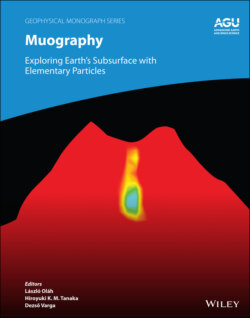Читать книгу Muography - Группа авторов - Страница 28
1.3.2 Magmatic Convection
ОглавлениеBy taking advantage of the resolving power of muography, we can address the following issues in volcanology: (i) conduit diameter (Tanaka et al., 2007a, 2007b, 2008; Tioukov et al., 2019) and three‐dimensional conduit location (Tanaka et al., 2010); (ii) depth of magma degassing (Tanaka et al., 2009a); (iii) magma convection and magma supply rate (Shinohara & Tanaka, 2011; Tanaka et al., 2009a); (iv) whether the magma pathway is plugged (Tanaka et al., 2007b; Tanaka & Yokoyama, 2008) or drained‐back (Kusagaya & Tanaka, 2015a; Tanaka et al., 2007a); (v) characterization of a high‐density spine inside a porous lava dome (Tanaka, 2016) or the magma intrusion underneath the volcano (Kusagaya & Tanaka, 2015b); (vi) the level of the magma head (Tanaka et al., 2014); (vii) volcanic plug explosion (Tanaka et al., 2009b) and formation (Oláh et al., 2019); (vii) lava dome explosion (Tanaka & Yokoyama, 2013); (ix) tephra deposition (Tanaka, 2020a); and (x) eruption forecast (Nomura et al., 2020).
Figure 1.4 Muographic image of Satsuma‐Iwojima volcano, Japan. The arrow indicates the location of the bubbly low‐density magma.
An example of how a muographic image can be used to understand the eruption dynamics is shown in Fig. 1.4. Statistical errors ranged from 0.02 to 0.2 g/cm3 above 250 m a.s.l. with the variation depending on the location in the volcano. Satsuma‐Iwojima, Japan, continuously emits large amounts of magmatic gases without a significant output of magma. The density gradually decreases up the conduit, and the top of the magma column at 400 m a.s.l. has the lowest density, indicating the presence of magma degassing, in agreement with the magmatic convection model (Shinohara & Tanaka 2011; Tanaka et al., 2009a). In this convection model, a magma conduit is connected to a deep magma chamber (Fig. 1.5), and in the upper part of the conduit, the gas escapes from the magma and exits the volcano. The degassed magma sinks, and, at the same time, new low‐density non‐degassed magma ascends from the bottom of the conduit and the cycle continues.
Degassed magma, which has a high proportion of bubbles, has been interpreted as being the low‐density region, and its dimensions (location and diameter) were compared with the following results of field measurements and laboratory and numerical modeling studies (Shinohara & Tanaka 2011). (i) The depth of the magma head observed 200 m below the crater floor was consistent with the degassing pressure of the magma and had a value of 0.5–3.0 MPa in Satsuma‐Iwojima (Kazahaya et al., 2002). (ii) High‐temperature (> 900 oC) volcanic gasses were continuously emitted from the vent (Shinohara & Tanaka, 2011). (iii) The oversaturation of volatiles in the melt was found, i.e., the degassing had been occurring under relatively low‐pressure conditions (Hedenquist et al., 1994). (iv) Gravity mapping of Satsuma‐Iwojima (with a residual profile derived from Bouguer anomalies assuming a density of 2.0 g/cm3) revealed that a low‐gravity region was located within the volcanic cone, which reached its lowest value in the crater region (Komazawa et al., 2005). The overall features of these results are consistent with the interpretation of this muographic result. Shinohara and Tanaka (2011) compared their muographic results with the results of gravity surveys of Masaya volcano, Nicaragua, and concluded that the low‐density region at the top of the magma column is a common feature of conduit magmatic convection. Conduit magmatic convection is often considered to be the degassing mechanism of basaltic volcanoes (Aiuppa et al., 2009; Burton et al., 2007; Oppenheimer et al., 2009; Shinohara & Witter, 2005; Shinohara et al., 2008). Significant and persistent degassing also occurs in silicic volcanoes during quiescent periods between eruptions (Delgado‐Granados et al., 2001; Edmonds et al., 2003; Kazahaya et al., 1994).
Figure 1.5 Conduit magmatic convection model of Satsuma‐Iwojima volcano.
The magma supply rate will be underestimated if only the geodetic modeling of the expansion rate of the volcanic body is applied. If the magmatic convection process is assumed as a model of magma degassing, the rate of the magma supply to the shallow part of the volcano will be estimated as more than one order of magnitude larger than the surficial expansion rate of the volcano (Kazahaya & Mori, 2016).
